By Daniel Ronan
PreservationNation
“Morally, there needs to be a defense of public art,” says Hector Duarte, an accomplished Mexican-American muralist and painter sitting in his Chicago home and studio of fifteen years.
Pilsen, his neighborhood, has been squarely Latino since the mid-1960s, and has been a haven for exploring the mural as an artistic medium. With murals up and down the community’s main thoroughfare of 18th Street, it’s hard not to spot several towering masterpieces depicting cultural, political, and religious themes exquisitely painted over 150-year-old masonry.
Originally a German and Irish neighborhood, and later Czech, Pilsen’s vibrant street life — now filled with taco joints, bodegas, and thrift stores — masks a broader struggle. With higher-than-average crime, increased development, and changing demographics, many consider the neighborhood ripe for gentrification. Moving south and west in the city, many Latinos have planted new roots in Little Village, affectionately called “La Villita” by the locals.
Broader demographic and neighborhood changes place the future of historic mural art into question. Can Pilsen hold onto its legacy of mural art given the increased pressures of development, the ephemeral nature of artwork exposed to the elements, and a shift in thinking of younger generations away from the lasting relevance of mural art?
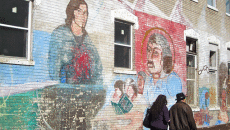
This shift in thinking is one Miguel Aguilar knows all too well. As an adjunct professor of the Art History Department at the School of the Arts Institute of Chicago, Aguilar teaches the history of graffiti and also explores the medium in his own portfolio work.
Aguilar notes a difference in opinion between graffiti artists and muralists about the question of permanence. New, typically younger graffiti writers tend to see the world as their canvas, open for constant rewriting; typically older mural artists see the value in leaving lasting testaments to times past.
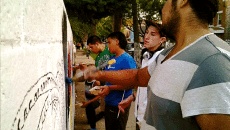
In the case of the Chicago Latino community, the fervor of the Chicano/Chicana movement of the 1960s and 1970s is typified by the murals of Casa Aztlan, the one-time headquarters for Mexican-American muralists.
While many of these murals, whose aim as public art is to incite social action, might align with a graffiti artist’s politics, the graffiti artist chooses instead to interpret these politics by tagging a wall with similar themes, all with the expectation the work will be gone tomorrow, a victim of a new artist’s interpretation. To graffiti artists — or writers, as they often call themselves — this approach achieves an additional aim: insuring that their art encourages a vibrant visual conversation.
One recent example, however, shows that the connection between the two art forms is more nuanced and, importantly, not dichotomous. In April 2013, Enlace, a Latino community group, and Father Tom Boharic of St. Agnes of Bohemia in Little Village, the neighborhood’s largest parish, came together to take a stand against street violence.
In a community splintered by gangs, “Father Tom,” as parishioners affectionately know him, was personally moved by the death of one of his catechism students to gang violence. He led the founding of Imago Dei, a murals group for 20 to 25 neighborhood youth.
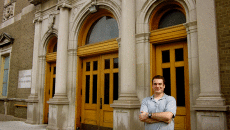
The new program teaches Little Village youth to paint murals on street corners along gang boundaries. Employing graffiti spray-painting techniques, the youth answer gang tagging with large murals using big-block Spanish words and religious iconography that promote messages of peace and community.
Working with property owners, as well as often-older immigrants of their parents’ and grandparents’ generations, the program cuts across generational lines, fostering communication and collaboration among neighbors.
“Little Village youth are sending a positive message across the city that they can be the source of positive social change in our neighborhoods through their work and creativity,” says Michael Rodriquez, Executive Director of Enlace.
Cheryl Cooke, Manager of Corporate Giving at Allstate, echoes the program’s success: “The Imago Dei program has changed the atmosphere of a once dangerous area to one of pride and sense of community.”
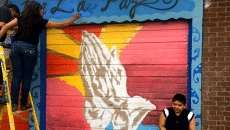
The success of this program has implications for preservation, too. When residents take control of their neighborhood by reclaiming their public spaces, it bodes well for future efforts in crime prevention, job creation, and community investment.
More than anything, Imago Dei represents the power of art to overcome the challenges faced by many communities of color. Latino communities are just the tip of the iceberg in addressing the need for more equitable outcomes and opportunities for many residents of the South and West Sides of Chicago.
Not coincidentally, many of these neighborhoods hold countless acres of vacant land and some of the city’s finest historic buildings, providing opportunity for a program like Imago Dei not to solve structural neighborhood problems, but rather to help foster more social capital to address broader disinvestment issues.
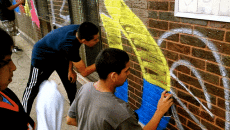
While perspectives of preserving mural art may differ depending on which writers of history one talks to or which street artists one meets, the will to make art should be valued as much as the will to preserve art and its history. It’s ensuring muralists, graffiti writers, artists, and community members alike all have a place in telling the story — and moreover, an understanding that their art and message, like their voice, matters no matter the medium.
Only then can we fulfill Hector Duarte’s call to action: “Lo que nececitamos defender es lo poquito que queda … What we need to defend is what little is left.”
The National Trust for Historic Preservation works to save America’s historic places.
Featured Photo: Muralist Hector Duarte in front of his Pilsen home and studio, with “Gulliver in Wonderland” mural.
Daniel Ronan is Site Projects & Public Engagement Coordinator at the National Public Housing Museum



